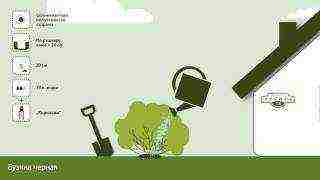Content
The genus Artemisia (Artemisia) from the Asteraceae family contains about 300 species of herbaceous and semi-shrub plants that grow in the wild in Europe and most of Asia and North Africa.
The value of decorative wormwood for the garden lies in its unusual silvery-gray foliage. The leaves of the plant are covered with thick silky hairs, subtle yellow or white flowers appear in July-August.
In Europe, there is a legend that the spicy smell of wormwood planted near the house is able to drive away evil spirits. We don't know what about spirits, but the culture is great at repelling mosquitoes on the site.
Several representatives of the genus are used as an ornamental plant in landscape design.
Schmidt's wormwood (Artemisia schmidtii), namely its ground cover variety "Nana", also known as "Silver Barrow" 10-25 cm high. The plant forms dense silver-green clumps with feathery foliage. It lends itself well to trimming, thanks to which you can form compact lush pillows. In winter, it can freeze, but quickly recovers. A spectacular hybrid of this species "Powis Castle" about 35 cm high with openwork pinnately dissected foliage.
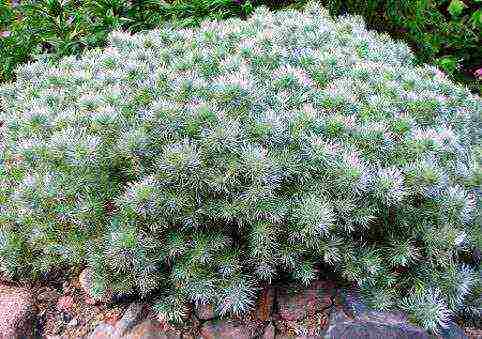
Steller's wormwood (Artemisia stelleri) and its varietal forms "Mori's Form" and "Boughton Silver" with silver-white fishnet leaves. The height of the varieties is about 30-40 cm.
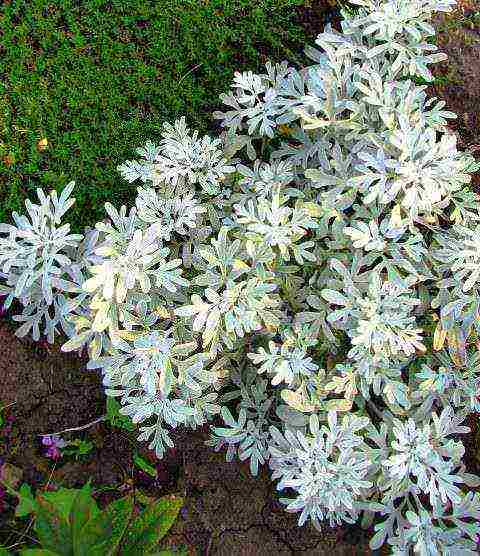
Louis' wormwood (Artemisia ludoviciana)... Its height is 50-80 cm. Narrow leaves of a bluish or silvery shade. Well-known varietal forms "Valeri Finning", "Silver Queen", "Silver King".
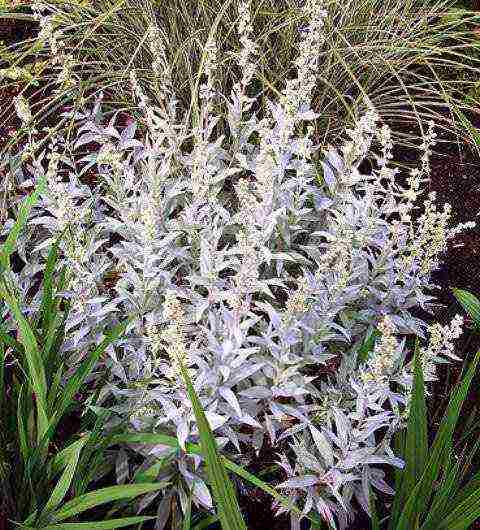
Wormwood Pursha (Artemisia purshiana)... Herbaceous semi-shrub plant with a branched stem 60-70 cm tall and elongated-oval white-gray leaves. Regular pinching of the top during the growing season allows you to form a beautiful lush bush.
Growing tips
The culture is completely undemanding to care. Wormwood in the garden grows well in full sun. Loves poor, well-drained soil; in fertile soil it loses its compact form. Like most silver-gray deciduous perennials, Artemisia is very resistant to drought and does not tolerate stagnant water that can kill the plant. However, immediately after planting, it needs regular, moderate watering for 2-3 weeks to root.
Since the culture grows well in poor soils, it does not need feeding at all. Throughout the season, caring for wormwood in the garden consists of weeding and pruning shoots in the fall or spring in tall species. Low varieties that form curtains over time begin to die off in the center, so every 2-3 years they need to be rejuvenated by division. The procedure is carried out in the spring.

The plant propagates mainly by dividing the bushes, root or stem cuttings, but the first method is the simplest and most effective.
Artemisia can be susceptible to fungal diseases such as powdery mildew, mold, white rust. High humidity and poor air circulation exacerbate these problems.
Application in landscape design
In the garden, wormwood looks advantageous in a composition with graceful fescue, blue kermek, lofant, sage, bright carnation herb, solar coreopsis, echinacea, variegated varieties of dwarf barberry, euonymus, spirea, lush santolina. The plant is an ideal candidate for a herb garden and alpine slide.
Planting wormwood next to cineraria, lamb, onosma and stachis will create an unusual silver-gray monochrome composition.
Did you like the article? Vote!
1 1 1 1 1 Rating 5.00
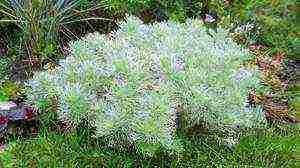 Today we will focus on such a plant as wormwood. Its silvery, carved leaves have inspired many gardeners to use it in landscaping. Very often it is used as an ornamental plant and decorates garden beds with it.
Today we will focus on such a plant as wormwood. Its silvery, carved leaves have inspired many gardeners to use it in landscaping. Very often it is used as an ornamental plant and decorates garden beds with it.
Wormwood is a common plant with a controversial reputation. This is one of the most tenacious weeds, which is almost impossible to remove without the use of special means and preparations. At the same time, the medicinal properties of wormwood have been proven long ago. She was treated in ancient times.
General information and some types
The wormwood plant is a herbaceous perennial of the Astrocyanaceae family. The plant has branched roots, which are covered with a silvery shade of fluff. It has straight stems with densely dissected leaves.
There are more than four hundred types of wormwood in the world, and each of them has invaluable properties. Citric and bitter wormwood is used for medicinal decoctions and infusions, bitter wormwood extract is very often used in perfumery and even in the production of such an alcoholic drink as absinthe and vermouth. Pets are fed with spreading wormwood. Many species serve as excellent soil fixers. Tarragon wormwood, better known as tarragon or tarragon, gives dishes an unusual aroma and magical taste.
The use of wormwood in landscape design is also very common. For poor sandy soil, these types of wormwood are perfect:
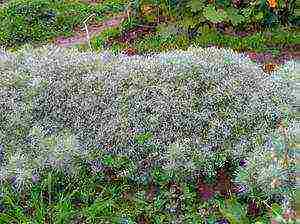 milky-flowered,
milky-flowered,- Stiller,
- Schmidt,
- Ludvik,
- pontic,
- Persian,
- Armenian.
Wormwood Louis
This cultivated plant is native to Seven America. Ludoviziana, as it is also called, is a perennial. This ornamental plant reaches a height of 80 centimeters and has a very developed and long root system. Its stems are densely pubescent and very durable, with silvery leaves on them. In order to form a compact Louis wormwood bush, you need to regularly pinch new shoots and remove the inflorescences.
Any garden will be decorated with Louis wormwood varieties:
- Valeri Finnig. It is a shrub with split leaves and loose stems. The leaf is greenish gray on the outside and white on the inside.
- Silver Queen. This bush is more branched and densely covered with foliage.
Wormwood Schmidt
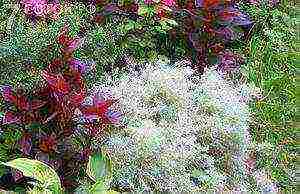 It is a perennial, which is rather densely covered with silvery lace leaves. Plant height can reach 15-30 centimeters. This is a very popular type of wormwood that looks great in a landscape ensemble with other plants and flowers. The most popular variety of Schmidt's wormwood is Nana. A compact bush in the form of a ball with threadlike dissected leaves has a simply stunning appearance.
It is a perennial, which is rather densely covered with silvery lace leaves. Plant height can reach 15-30 centimeters. This is a very popular type of wormwood that looks great in a landscape ensemble with other plants and flowers. The most popular variety of Schmidt's wormwood is Nana. A compact bush in the form of a ball with threadlike dissected leaves has a simply stunning appearance.
Steller's wormwood
This plant is very popular for its beautiful openwork leaves. They give the plant extraordinary beauty. Leaves of silvery color remain decorative throughout the season, grow back in spring and at the same time exude a specific pleasant aroma.
Although the plant blooms and it happens in mid-July, its flowers are not particularly valuable for the appearance of the bush. Flowers are generally recommended to be removed, since they cover the plant itself. Leaves, very similar to deer antlers, seem to spread over the soil, and such a miniature and very neat plant looks simply amazing in any garden.
This variety very well coexists with bright flowers - phlox, herbal carnation and yarrow.
Reproduction
 Any type of wormwood reproduces very well by grafting, using segments of the root system, as well as by dividing the bush.
Any type of wormwood reproduces very well by grafting, using segments of the root system, as well as by dividing the bush.
If the first breeding option is chosen, then this should be done either in late spring or early summer. It is necessary to cut the apical shoots to ten centimeters.This should be done at an angle, and then the cut off shoots should be cleaned from the lower leaves and lowered into a container with sand. The bush is transplanted to a permanent place in open ground, after a year. If the gardener can find such a place for the bush that will meet all the necessary conditions, then in this case, the plant can be planted immediately in open ground in a permanent place. Moreover, it should be very well lit and the soil should be sandy and light. In such conditions, the cuttings adapt perfectly and take root.
The division of the bush is done, as a rule, in the fall. And the method of reproduction by segments of the root system is best carried out during this period.... In both cases, you need to dig out the bush., divide the root system into several parts and transplant them to new permanent places.
Growing rules in your garden
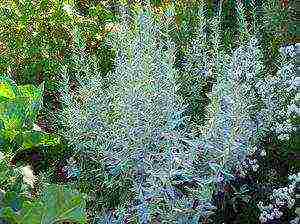 Ornamental wormwood is considered a rather unpretentious plant and feels fine in light soils in well-lit places. However, it will die very quickly in clay soil. In the spring, you need to choose a planting site, carefully dig it up and mix the soil with compost or other organic matter and sand. The plant can be planted immediately afterwards.
Ornamental wormwood is considered a rather unpretentious plant and feels fine in light soils in well-lit places. However, it will die very quickly in clay soil. In the spring, you need to choose a planting site, carefully dig it up and mix the soil with compost or other organic matter and sand. The plant can be planted immediately afterwards.
In order for the bush not to grow like a weed in the garden, it is necessary to limit the development of its rhizome. To do this, when landing in the ground, you need to dig in 30 centimeters of the curb tape. Another option is to grow the plant in separate containers or pots.
If you overdo it with watering, then you can influence the abundance of pubescence, and then the plant will lose its decorative effect. That is why it is necessary to water it only during prolonged drought; it is not worth sprinkling the foliage with water at all.
The plant can be susceptible to a disease called powdery mildew. This usually occurs during prolonged rainy weather. A special drug, a fungicide, will help to cope with the disease.
During the flowering period of the bush, it is imperative to remove all inflorescences, because the formation of ovaries will lead to the dispersion of seeds throughout the site.
Use in garden landscaping
 It is widely used in landscape design and decoration of park and garden flower beds. The silvery bush creates a very beautiful composition in the vicinity of other garden dwellers, while its aroma successfully repels all kinds of flower pests. Such a plant on the site will not only bring aesthetic pleasure to the grower, but will also be incredibly useful.
It is widely used in landscape design and decoration of park and garden flower beds. The silvery bush creates a very beautiful composition in the vicinity of other garden dwellers, while its aroma successfully repels all kinds of flower pests. Such a plant on the site will not only bring aesthetic pleasure to the grower, but will also be incredibly useful.
Low-growing varieties of the plant are usually used in the design of alpine slides and borders. The Louis Variety goes well with low bells, barberry, cloves or sage. High varieties coexist beautifully with roses.
Conclusion
In conclusion, I would like to say that growing this ornamental plant on your site will not take a lot of time and effort from the grower. It does not require special attention and care, but it will perfectly fit into any garden composition and, perhaps, even become its main decoration.
> Decorative wormwood

The beauty of the silvery dissected leaves of wormwood inspired flower growers to use some of this plant in garden decoration.
Wormwood is one of the most common herbaceous plants with a highly controversial reputation. Its remarkable healing properties have been known since antiquity. At the same time, wormwood is one of the most tenacious weeds.
General information
Wormwood is a perennial (sometimes annual) herb of the Astrotsvetna family. The plant has a lignified branchy root system, covered with a silvery downy straight stems and dissected leaves.
More than 400 species of wormwood are known, each of which has invaluable properties. Wormwood and wormwood used for the preparation of medicinal broths, extracts from wormwood used in the perfumery industry and in the production of absinthe and vermouth, wormwood spreading serves as food for pets. Some types of wormwood are good soil fixers. Tarragon wormwoodknown as tarragon, or tarragon, gives dishes incredible taste and magical aroma.
In landscape design and for landscaping areas with sparse sandy soil, tall and low-growing types of decorative wormwood are used - Steller's wormwood, wormwood Schmidt, wormwood lactobacillus, wormwood Louis, mountain wormwood, wormwood, wormwood, wormwood persian.
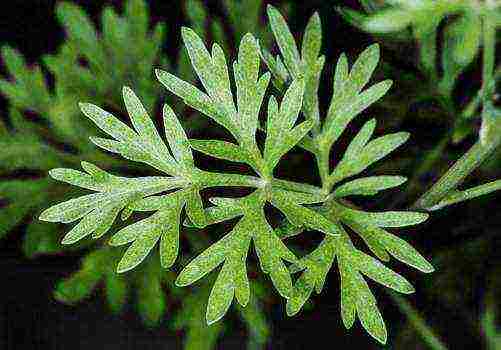
Sagebrush
Wormwood Louis
A cultivated native of the prairies of North America, Louis Wormwood, or Louisiana, is a perennial ornamental plant up to 80 cm high with a long rhizome, strong densely pubescent stems and silvery-gray leaves. In order to form a compact bush from this species of wormwood, inflorescences should be removed in a timely manner and the shoots should be pinched.
A wonderful decoration of the garden can be the varieties of Louis wormwood - Valeri Finnig and Silver Queen. The first variety is a shrub with weakly branched stems and dissected leaves, greenish-gray on top and almost white on the inside.
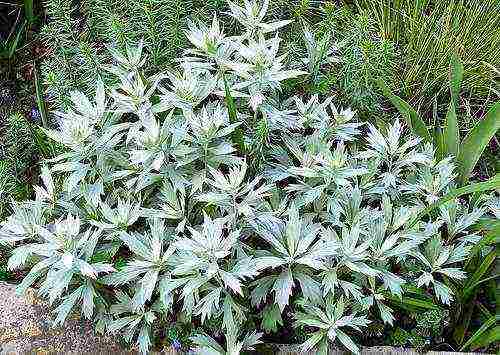
Wormwood Louis Valeri Finnig
The fast growing wormwood of Louis Silver Queen is distinguished by more branched stems, densely covered with pubescent silvery-gray leaves.
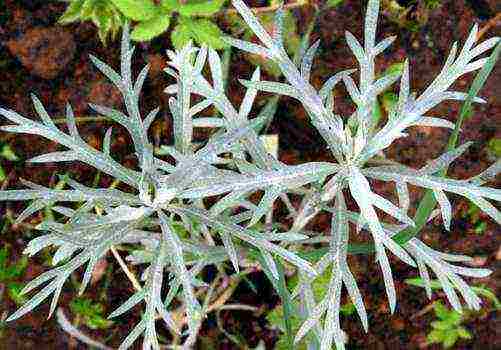
Wormwood Louis Silver Queen
Wormwood Schmidt
Wormwood Schmidt is a perennial undersized densely pubescent shrub with a height of 15 to 30 cm with strong stems and "lacy" silvery leaves. The plant is one of the most popular ornamental crops, which looks especially advantageous in combination with other flowers in the flower bed. One of the most common varieties of Schmidt's wormwood is Nana. It is a small spherical bush with silvery green, pinnately dissected, threadlike leaves.
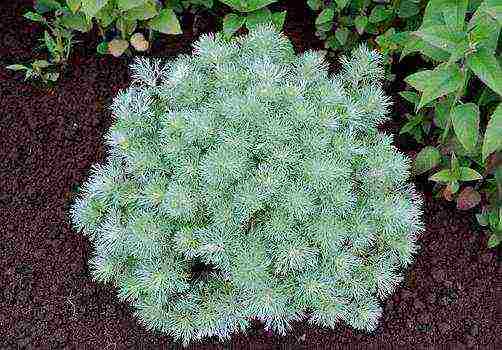
Wormwood Schmidt Nana
How to propagate wormwood
All types of decorative wormwood reproduce easily cuttings, rhizome segments, dividing the bush... Propagation by cuttings is best done in late spring or early summer. To do this, cut off at an angle the apical shoots up to 10 cm long, remove the lower leaves and plant in containers with sand. You can transplant to a permanent place in a year. If it is possible to create ideal conditions for growing wormwood - to find a well-lit area with light sandy soil in the garden - the cuttings can be planted immediately in open ground.
In early autumn, you can start reproduction by dividing the bush and segments of the rhizome. In both cases, the plant should be dug up, the rhizome divided into several parts and planted in new places.
Conditions for growing wormwood
The unpretentious and drought-resistant decorative wormwood will feel great in a light sandy soil in open, well-lit places, but will die in heavy soil with a high clay content. In the spring, having chosen a suitable site, you should dig up the earth with compost and sand and immediately plant the plants.
To prevent wormwood from spreading throughout the garden, it is recommended to limit its root system with a curb tape dug into the ground to a depth of 20-30 cm, or grow it in flowerpots and containers.
As a result of excessive glaze wormwood can lose its pubescence and, along with it, lose its decorative effect. Therefore, the plant should be watered only during periods of prolonged drought; it is not necessary to spray from above.
In a rainy summer, wormwood can strike powdery mildew, which is easy enough to cope with by treating the plant with a fungicide. During the flowering period, it is better to remove the inflorescences so that ovaries do not form and the seeds do not scatter throughout the garden.
Use in garden design
The area of application of decorative types of wormwood in landscape design and in the design of flower beds is extremely diverse.The plant with beautiful silvery leaves creates picturesque color compositions, while at the same time repelling harmful insects with a tart, bitter aroma.
Low-growing species are used for decoration curbs, alpine slides, rockeries... Louis' Silver Queen's wormwood goes well with Thunberg's barberry, Steller's wormwood - with low bells, sage, and herbal cloves. Tall species give a special charm to flower beds, rose gardens, mixborders.
